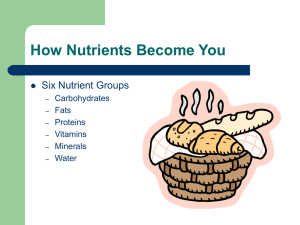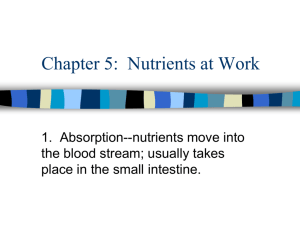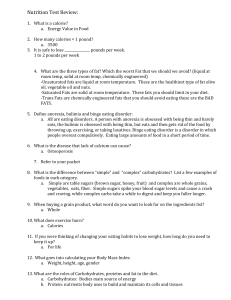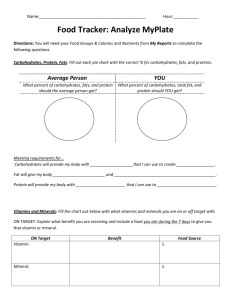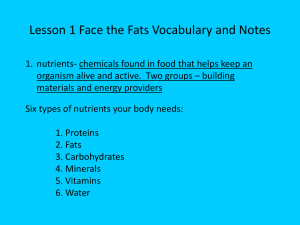Nutrition and Digestion Study Guide
advertisement
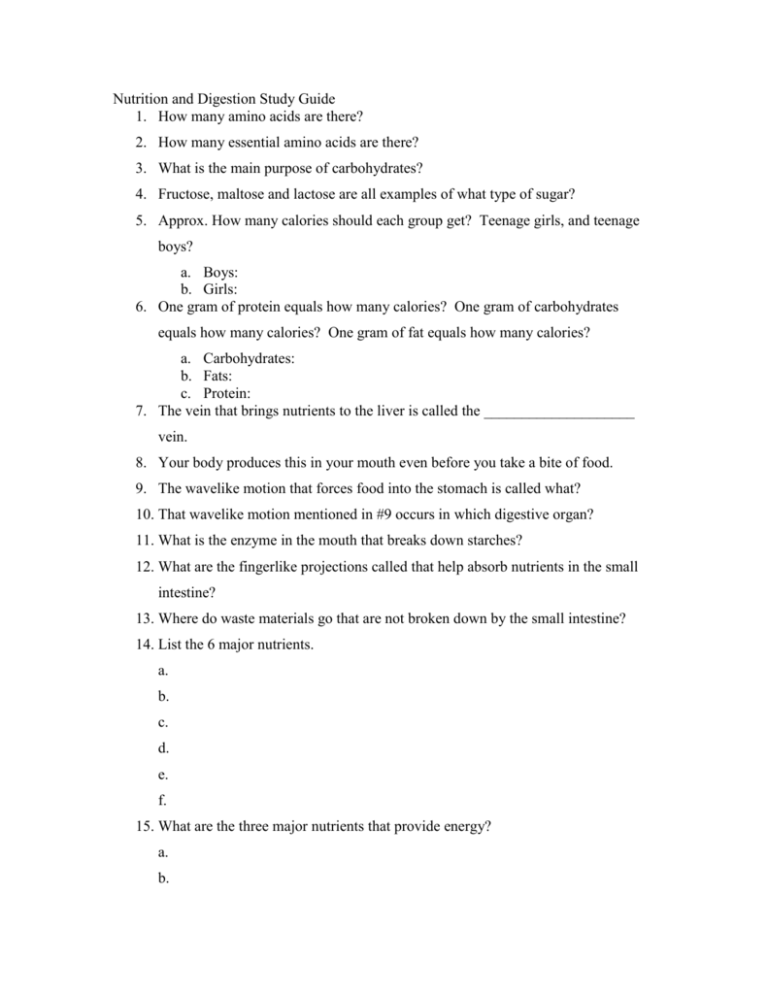
Nutrition and Digestion Study Guide 1. How many amino acids are there? 2. How many essential amino acids are there? 3. What is the main purpose of carbohydrates? 4. Fructose, maltose and lactose are all examples of what type of sugar? 5. Approx. How many calories should each group get? Teenage girls, and teenage boys? a. Boys: b. Girls: 6. One gram of protein equals how many calories? One gram of carbohydrates equals how many calories? One gram of fat equals how many calories? a. Carbohydrates: b. Fats: c. Protein: 7. The vein that brings nutrients to the liver is called the ____________________ vein. 8. Your body produces this in your mouth even before you take a bite of food. 9. The wavelike motion that forces food into the stomach is called what? 10. That wavelike motion mentioned in #9 occurs in which digestive organ? 11. What is the enzyme in the mouth that breaks down starches? 12. What are the fingerlike projections called that help absorb nutrients in the small intestine? 13. Where do waste materials go that are not broken down by the small intestine? 14. List the 6 major nutrients. a. b. c. d. e. f. 15. What are the three major nutrients that provide energy? a. b. c. 16. What are the four Fat Soluble vitamins? ___________,____________,_____________,_______________ 17. Name the water soluble vitamins. 18. What are the four types of fatty acids (fats) that we’ve discussed? a. b. c. d. 19. What are the three minerals that are electrolytes and keep the fluid balance in the body? a. b. c. 20. What is the smallest form of sugar, which carbohydrates are broken down into? 21. What do fats break down into? 22. What percentage range of calories should you have from the following nutrient group? a. Carbohydrates: b. Fats: c. Proteins: 23. What are the building blocks of proteins? 24. What organ is responsible for turning nutrients into different kinds needed by the body (the distribution center)? 25. What is the name of the churned food that is released from the stomach to the small intestine? 26. What are the three digestive juices released in to the small intestine? a. b. c. 27. What is soluble fiber? 28. What is insoluble fiber? 29. What are complete proteins? 30. What are incomplete proteins? 31. HDL is referred to as the _________________________ cholesterol. 32. LDL is referred to as the _________________________ cholesterol. 33. What are refined sugars? 34. What are four examples of refined sugars? a. b. c. d. 35. In what food sources is cholesterol found? 36. How can a person become malnourished? 37. Can a person who has enough money to buy food become malnourished. A digestive story: Fill in the blanks below to complete the digestive steps. After entering grandma’s house and smelling the delicious cookies she had baking, the digestive story began. First, when I smelled the cookies my mouth began to “water” as it is sometimes called. That water is actually my ________________________, which has an enzyme in it called __________________________ that works with my teeth to chew and break down my cookies so that I can swallow them. Once I do swallow the cookies they travel through my __________________________ where my_________________________ pushes the partially digested food into my _____________________________. All this work so that I can eat a cookie! Now that the cookie is in my stomach, there are ______________________ juices that will begin to break down my food even further. That juice will break down the food so much that it turns into a mush called _________________________. Next, that substance will travel into my ______________________ intestine where it is broken down even further. With the help of the “3 juice cocktail”, consisting of _______________________________, _____________________, and _________________________. Now the food is really broken down. Some of this digested food will leave the body by traveling through the ________________________ intestine into the anus, and the rest of the digested food will be absorbed through the ________________ and travel through the ______________________vein into the ______________________ where it is distributed where ever it is needed in the body as nutrients.


